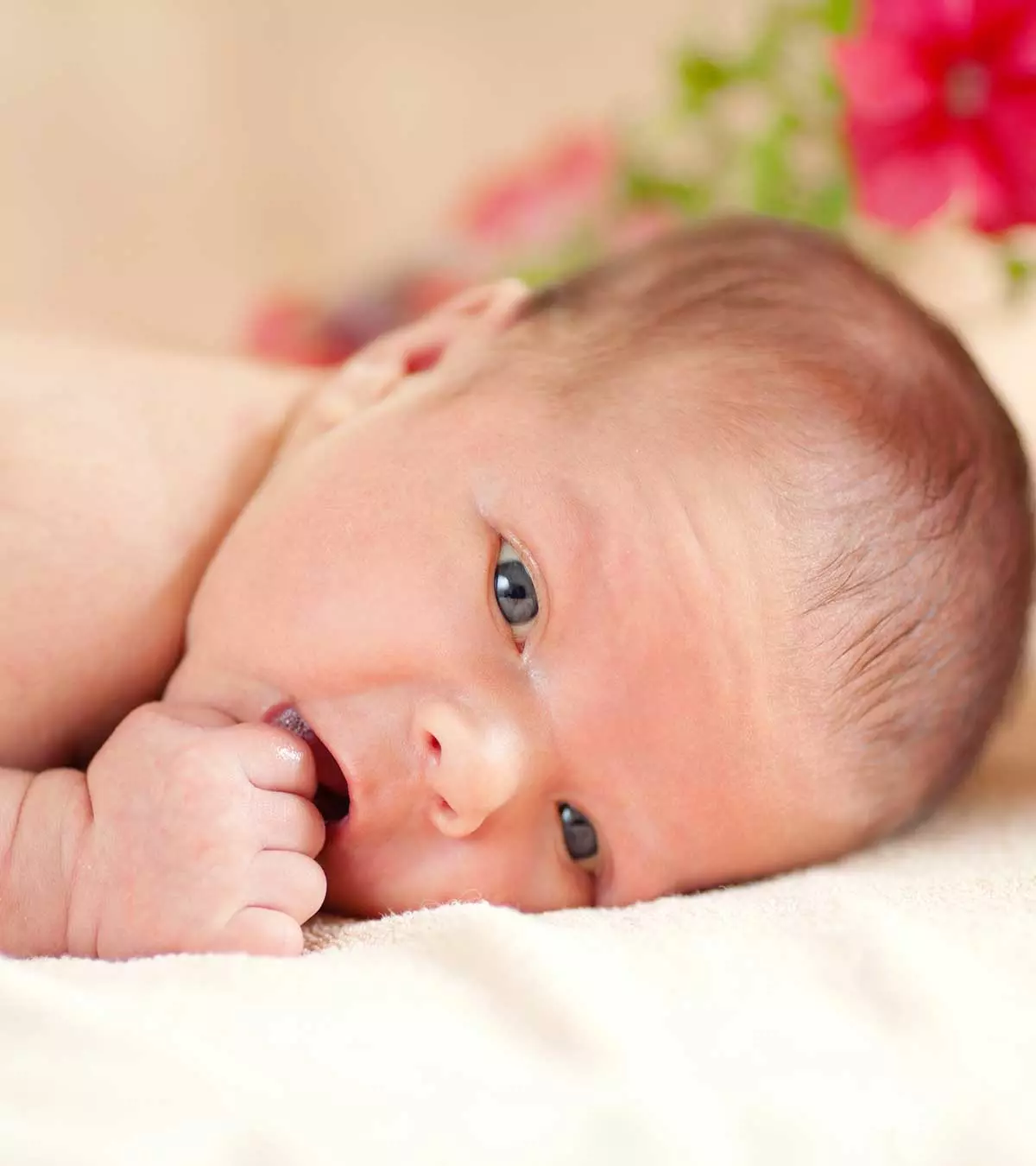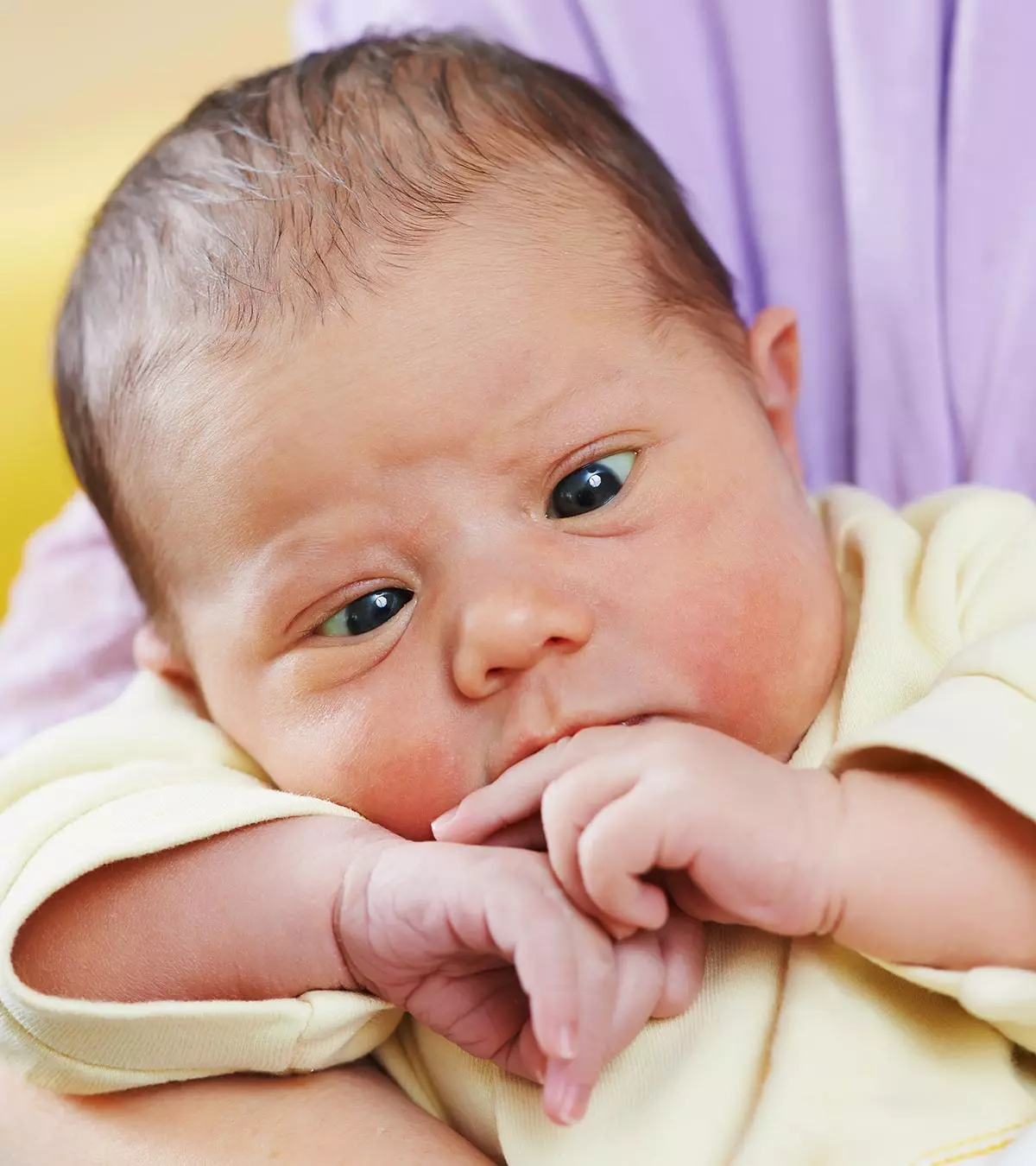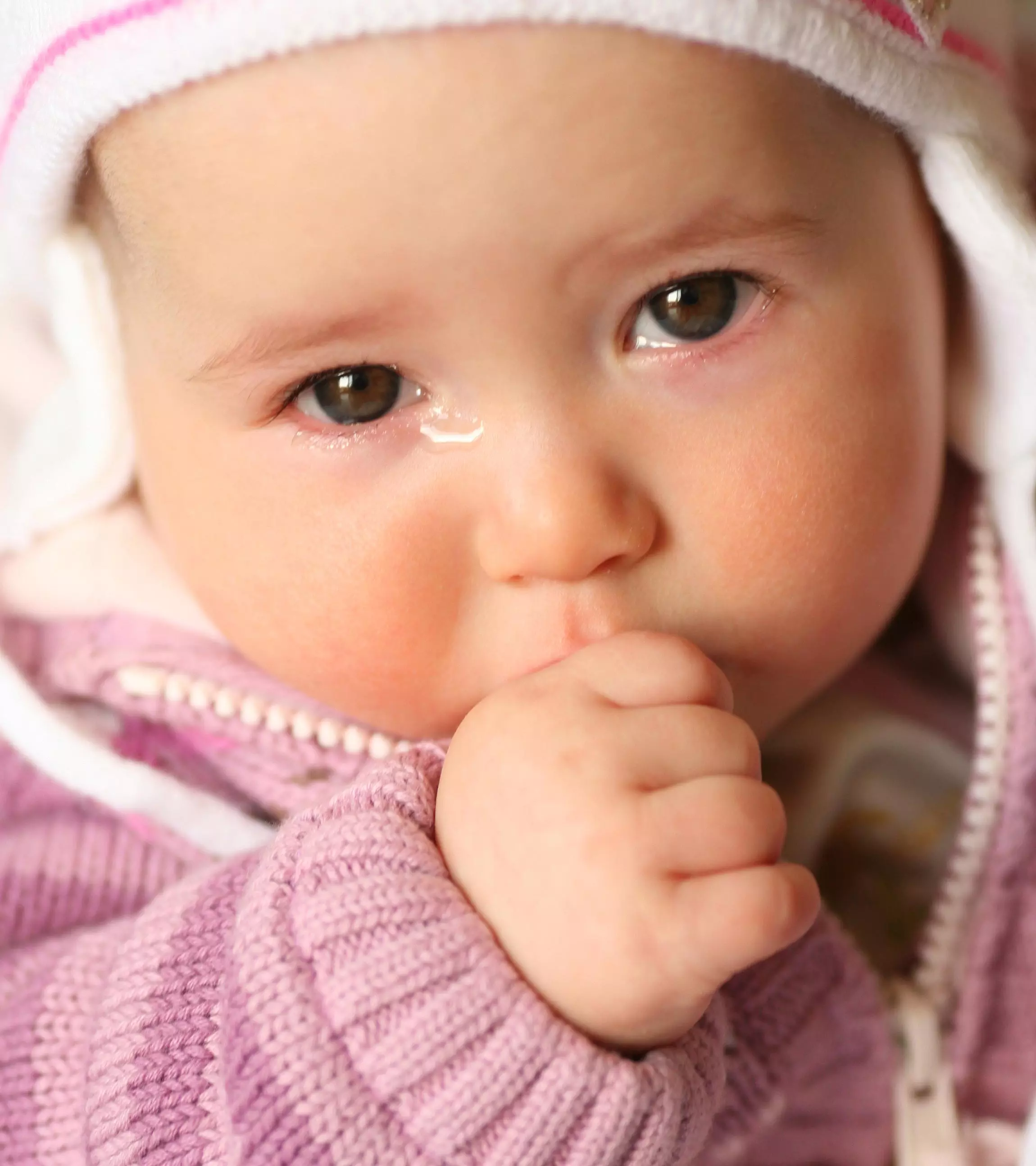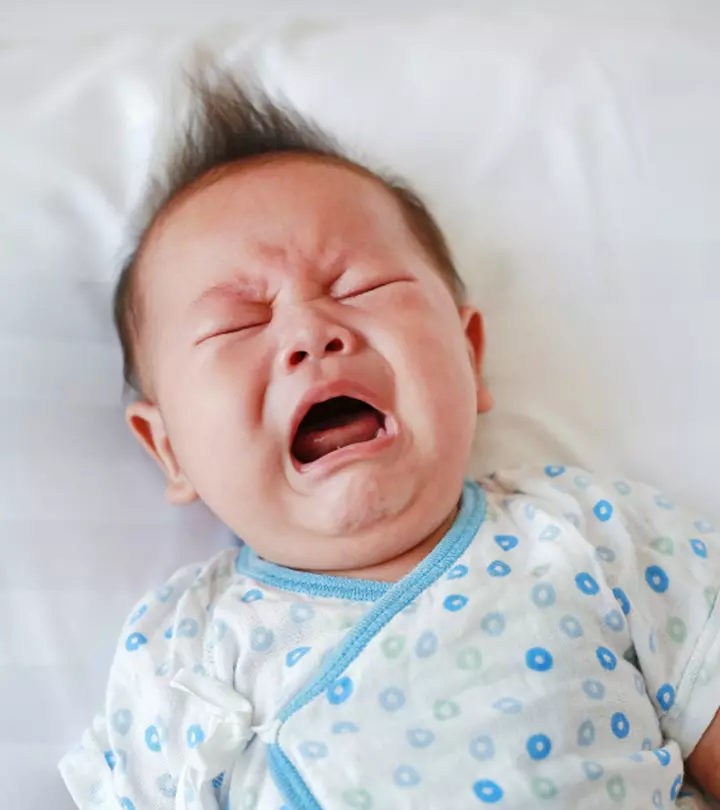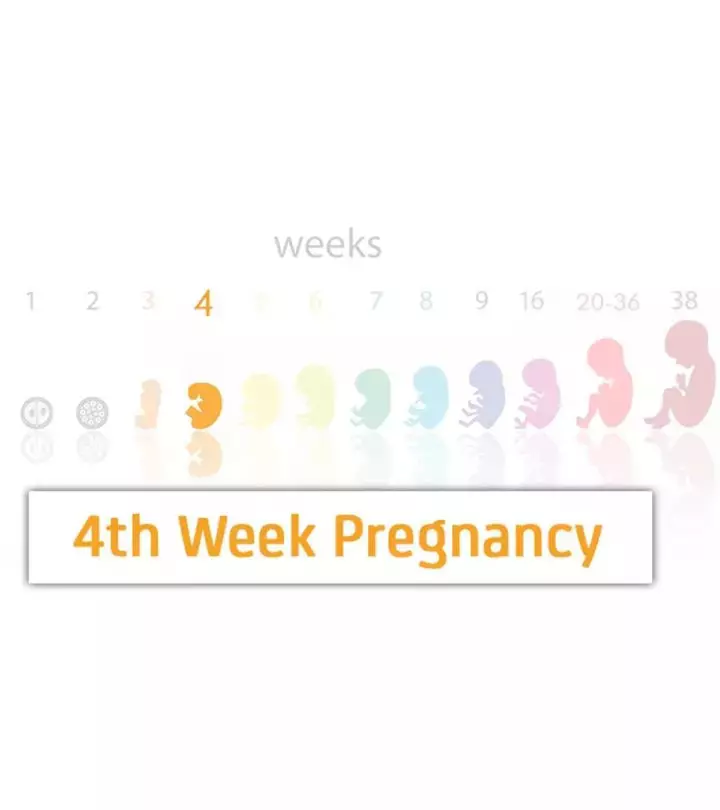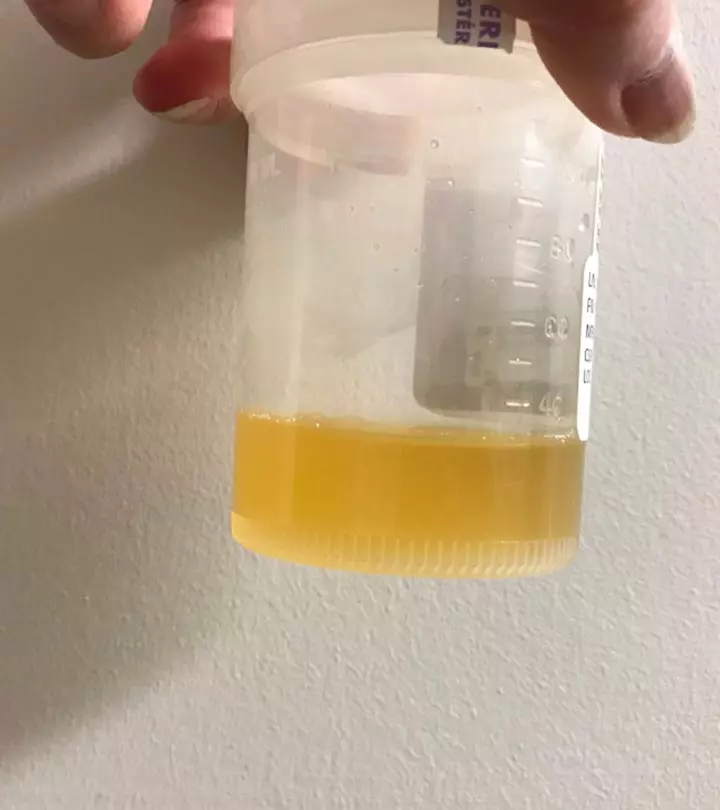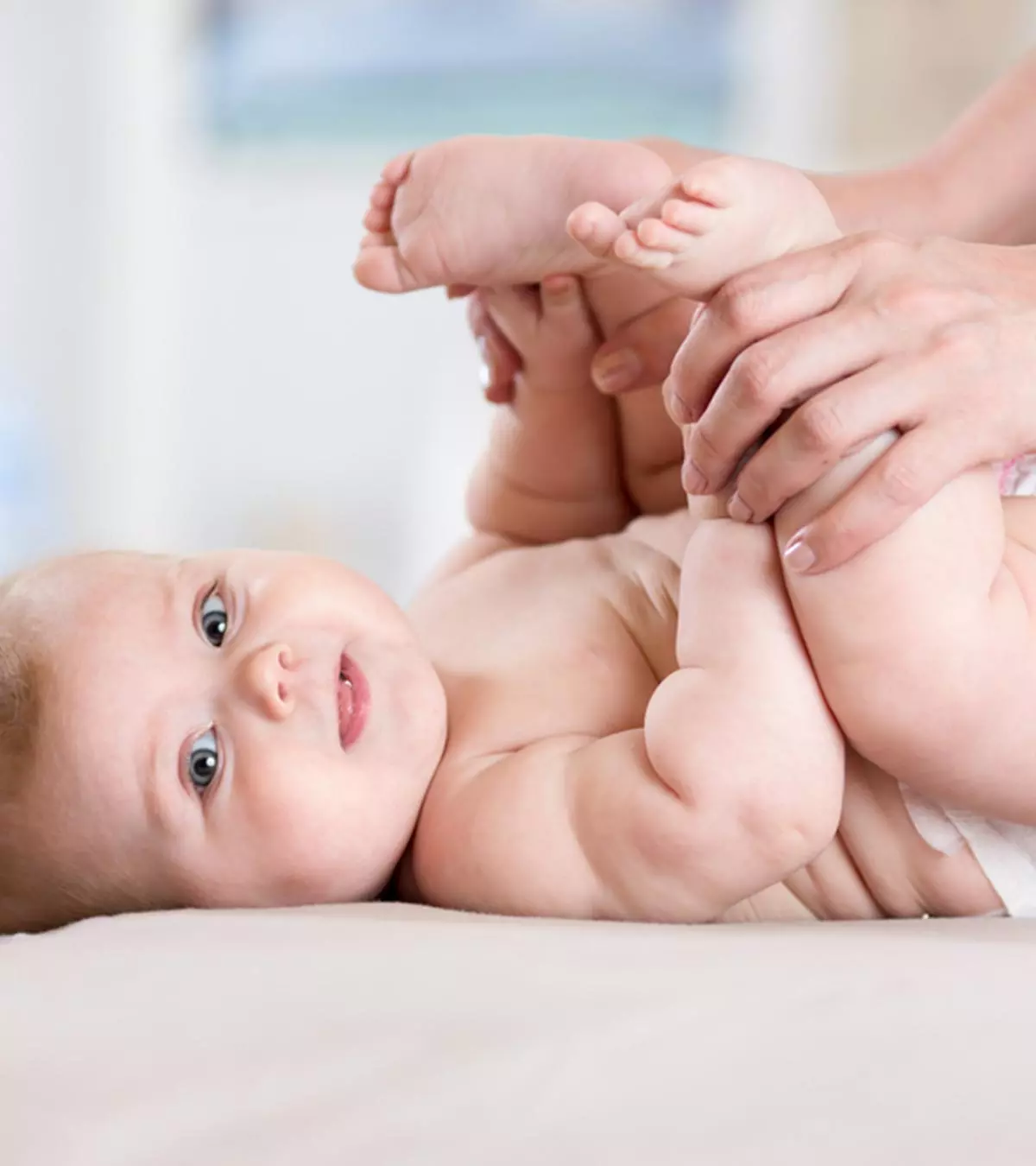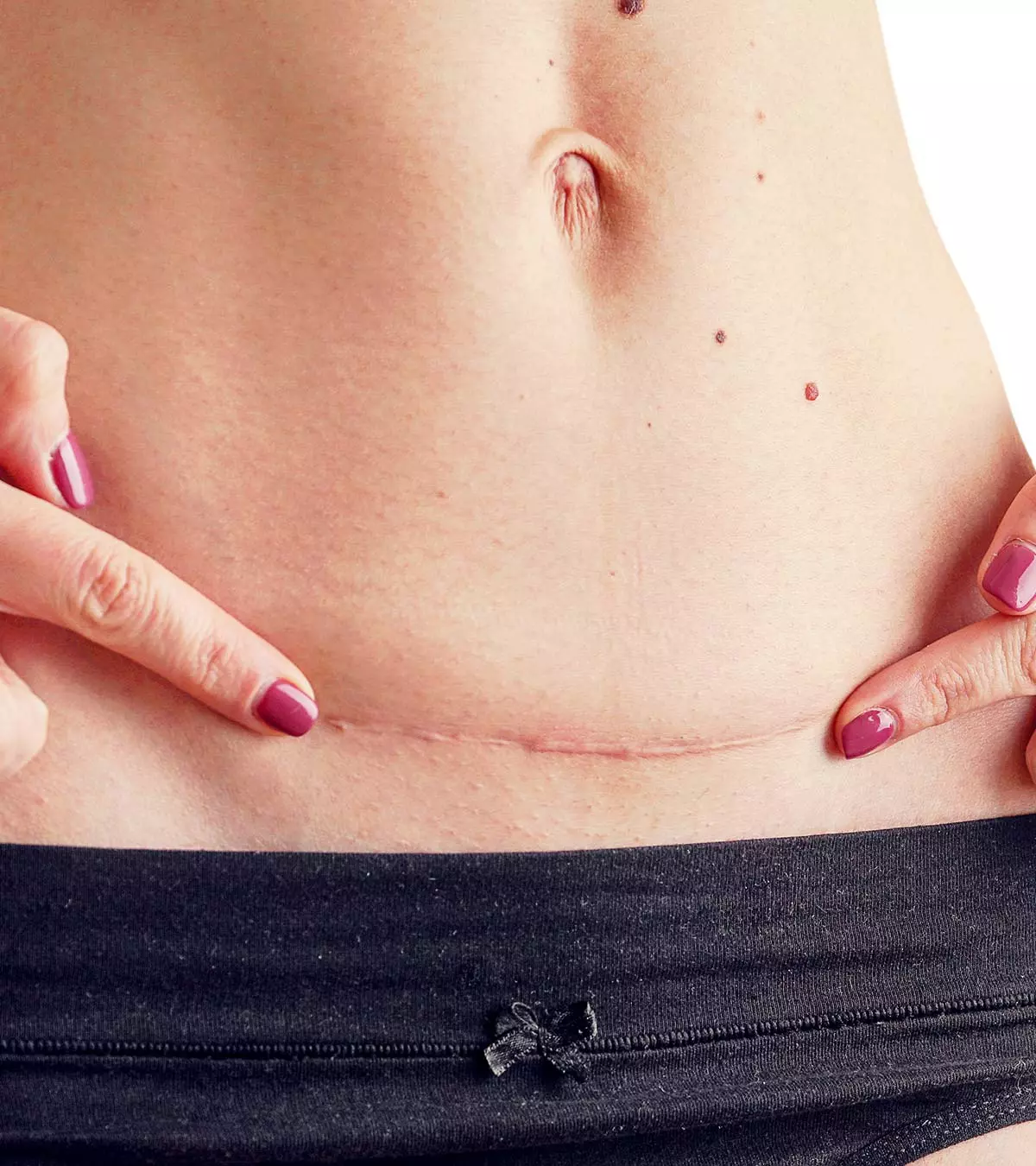
Image: ShutterStock

According to the American College of Obstetricians and Gynecologists (ACOG), about one in every three babies in the US is delivered through C-section (17). However, it is worth noting that about 3-15% of women who deliver through a C-section develop a C-section scar infection (1). Since the number of women giving birth through C-sections has increased significantly in the past few decades, a prompt diagnosis and management of C-section scar infection is pivotal in improving its prognosis and preventing complications. Read this post to learn more about the causes, signs, diagnosis, treatment, and prevention of C-section scar infection.
Key Pointers
- A C-section scar infection develops post-cesarean delivery, resulting from obesity, diabetes, etc.
- Fever, abdominal pain, and bleeding may indicate an infection and needs immediate attention by a doctor.
- Cleaning and dressing the wound regularly would promote healing.
- To avoid C-section scar infection, a pregnant woman should maintain her weight and keep other health issues in control.
What Is A C-Section Wound Infection?

Cesarean section (C-section) is a major obstetric surgery when the baby is delivered by making an incision in the mother’s abdomen and uterus. A C-section wound infection, also known as post-cesarean section wound infection, is a bacterial infection that develops after cesarean delivery. It is due to bacteria infecting the surgical site (2). The infection could usually happen due to numerous types of bacteria and may be a superficial skin infection or a more dangerous deeper pelvic wound abscess. It is essential to be seen by a doctor as soon as possible to diagnose and treat the problem.
What Are The Causes Of Infection After Cesarean Birth?
The following are the common causes that may increase the risk of C-section wound infection (3) (4) (5):
- Obesity and increased weight: Obese and overweight women are at higher risk of developing C-section wound infection because obesity impairs blood flow which in turn leads to poor wound healing. The reduced wound healing ability eventually favors skin microbes to infiltrate the wounded tissues. Additionally, the excess weight also compromises the immune system and is associated with coexisting diseases, thus, further delaying wound healing (18)(19)(20).
- Previous cesarean delivery: After each cesarean delivery, thick bands of scar-like tissue, also called adhesions, are formed at the surgical site. This can lead to complications, such as surgical site infection (SSI) and bleeding when a new incision is made at the same site (21).
- Diabetes: Pre-existing diabetes or gestational diabetes can increase the risk of C-section wound infection. The high blood glucose levels can impair immune function and negatively impact blood circulation which affects the body’s ability to fight infection and lower wound healing ability (19)(22).
- Intraamniotic infection: Also known as chorioamnionitis, it is a bacterial infection that occurs in the tissues or membranes surrounding the fetus, and it usually develops during labor (23). So, the bacteria may move to the surgical site when a C-section is performed, thus, increasing the risk of post-ceasarean wound infection.
- Prolonged rupture of membranes (PROM)iA condition when the amniotic sac ruptures before the onset of labor contraction. : If the amniotic sac ruptures for a considerable time before the onset of labor, it can expose the uterus and surgical site to bacteria from the vaginal canal. The incident rate of infection further increases with the duration of rupture (24).
- Prolonged labor duration: Studies suggest that mothers who experience prolonged labor before delivery are at much higher risk of SSI. Prolonged labor causes dehydration, and fatigue and is also associated with repeated vaginal examinations which can increase the chances of ascending infection and may eventually lead to surgical site infection (25).
- Repeated vaginal examinations: Frequent vaginal exams during labor have been found to increase the risk of C-section wound infection due to ascending infection that leads to secondary spread to the surgical site (26).
- An emergency cesarean delivery: Various studies show that the incidence rate of SSIs is higher in emergency C-section deliveries than in planned C-sections (27). This could be primarily due to insufficient time or less preparation time to administer antibiotic prophylaxis in emergency and urgent cesarean deliveries due to maternal and fetal distress. According to the current American College of Obstetricians and Gynecologists (ACOG) recommendations, all pregnant women undergoing cesarean delivery should be given antibiotic prophylaxis at least 50 minutes before the incision. Therefore, the failure to adhere to antibiotic prophylaxis in these surgeries increases the risk of wound infections (28).
 Quick fact
Quick factKnowing the symptoms of a c-section infection can help you start the treatment in time.
What Are The Signs Of A Post-Cesarean Wound Infection?

If you’ve undergone a cesarean delivery, knowing about the potential signs of C-section scar infection is important to ensure you know what is expected and what is unusual. The following are a few symptoms of an infection after C-section:
- Fever and possible chills typically with a temperature higher than 100.4 F can be one of the symptoms of a c-section infection. Swelling, redness, or increased pain around the incision or surgical site. Any fluid coming out from the incision, an opening of the incision, and malodorous vaginal discharge are also c-section infection symptoms (6).
- Discomfort or pain in the lower abdomen region for several days after the surgery.
- Heavy bleeding and difficulty while urinating are also signs of a c-section infection. In addition to this, you could experience pain and a burning sensation while urinating, and blood in the urine if you have developed an infection (7).
If you have noticed any of these symptoms, consult your doctor for a proper diagnosis.
How Is A Post-Cesarean Wound Infection Diagnosed?
The doctor would check for tenderness, fever, swelling, or any other sign that could indicate an infection. Daily inspection of the incision site is the most vital part of the postoperative diagnosis. However, most of the infections start to appear after a week of surgery. Therefore, doctors advice new mothers to be attentive to these signs. If you see the symptoms, visit the doctor for further diagnosis and timely treatment (8).
How Is The Wound Infection Treated?

A c-section infection can be treated using (5):
- Antibiotics: Doctors usually recommend treating cesarean wound infections such as cellulitis with antibiotics. If caught early, oral antibiotics are used, however for more advanced cases, intravenous antibioticsiAntibiotics administered into a vein via an injection or catheter to treat or prevent bacterial infections may be necessary.
- Drainage: For cases where there is a pocket of abscess or pus, opening the skin incision to allow drainage of the infection may be warranted.
Faith Womack, a mother of two from the USA shares her experience of getting infection after cesarean birth. She says, “A month after birth, my C-section wound became infected. My whole abdomen became red, inflamed, and bloated and I was in a lot of pain.
“Finally my husband got me an appointment with my doctor and the doctors told me, ‘Yes, you’re infected.’ She drew the line around the infection and it was just 2 inches above my incision. She prescribed me some antibiotics and told me to come back after a week. But it got worse in two days. I was in so much pain that I can barely breastfeed my child. So I went to the obstetrics clinic again and my doctor told me that I’ll have surgery today.” She later had surgery (i).
- Dressing the wound: Some infection conditions may require dressing the wound regularly to close the wound and promote healing.
The treatment can be effective and your recovery faster when you follow a few tips.
How To Take Care Of A C-Section Infection Wound?

Here are some things that you need to take care of a C-section scar:
- Take and complete the antibiotics.
- Go for regular cleaning and dressing of the wound as directed.
- Avoid applying any lotions or creams that may contain chemicals harmful to your skin. And wear loose and lightweight clothes that don’t rub on your wounds.
- You can always get postpartum medical care from your doctor if the wound doesn’t seem to heal or if you experience more pain at the surgical site.
- Consume healthy food and lots of liquids.
- Prioritize rest, stay hydrated, and be sure to attend all your postpartum check-ups to support proper healing.
Norma Hess, a blogger and a mother of five, shares about her C-section site infection. She says, “Last week I started having some odd pain on the left side of my incision and upon checking it Friday night, I noticed some oozing. I thought, “great, and on a Friday night to top it off!” I called my OB and he said not to worry, this type of stuff can happen and that unless I had a fever I should be fine. I took his word for it and took it easy all weekend but I also made sure I kept the area really clean and dry. I decided to add a topical ointment to make sure there was no bacteria growing near the area. Well, this past Friday night… yes, Friday, AGAIN. My pain got a LOT worse and the area was red and swollen. When I showered that night and cleaned my incision, I felt stinging and everything just felt wrong. I was scared and I knew I now had an infection in my hands (ii).”
 Quick tip
Quick tipKeep reading to learn how you can prevent an infection or minimize its risk.
What Are The Stages Of C-Section Scar Healing?
The following are the three different stages for a C-section scar to heal (9):
- Inflammatory Stage: The initial stage, known as the inflammatory phase, usually lasts a few days following a c-section. This is the point at which the bleeding stops and the body sends white blood cells to the site of the wound to prevent infection. You may notice some swelling and a reddish or pinkish color at the incision site during this phase. Keep an eye out for any signs of infection.
- Proliferative Stage: At this stage, fibroblast cells gather and multiply at the site of the incision. These cells perform an important role in strengthening the incision site and bringing its edges closer together by making collagen. As this occurs, the c-section scar gets thicker and as it contracts, the color changes. The phase lasts for about three to four weeks.
- Remodeling Stage: At this stage, the once dense and puffy scar tissue progressively flattens and loses its color. This is the time when the c-section scar is expected to diminish and improve in appearance. The stage may last for months to years.
Can You Prevent C-Section Wound Infection?

You may not be able to prevent the infection after a C-section entirely, but you can take certain precautions to avoid any complications.
- Maintain a healthy weight: Obesity is one of the risk factors of a c-section wound infection (18). Hence, pregnant women should try maintaining their weight during pregnancy by exercising or consuming a healthy diet.
- Control diabetes: Gestational diabetesiA condition where the pregnancy's hormonal and physical changes interfere with the body's use of insulin, causing an elevated blood sugar could cause more complications related to the infection after a c-section (10). Therefore, pregnant women should try keeping their glucose levels in check.
- Treat other conditions/diseases: If you are suffering from any disease/illness or have any pre-existing conditions that may trigger complications with a c-section infection, try to treat them before the due date.
Frequently Asked Questions
1. Why does my C-section scar hurt?
In rare cases, the endometrial tissue grows at the site of a C-section scar. This tissue may grow outside or inside the uterine walls, hurting the scar. Treatment may involve medical or surgical intervention (11) (12).
2. How many C-sections can a woman have?
Every woman is unique, and so is their body. Since the risk of C-sections starts increasing after the third cesarean, experts recommend that women can have a maximum of three C-sections (13).
3. Is it normal for a C-section incision to pus?
No. While you may experience swelling and redness at the incisioniA cut in the body made for surgical purpose site after cesarean delivery, pus seeping out from the incision site is a sign of surgical site infection (6).
4. Can internal stitches open after C-section?
Yes. The internal cesarean incision on the uterus can also open or rupture following a cesarean delivery. However, its occurrence is rare (14).
5. How many layers are cut during C-section?
During a cesarean section, three layers of the uterus, including the serosal outer layer (perimetrium), the muscle layer (myometrium), and the inside mucosal layer (endometrium), are incised (15).
C-section scar infection is uncommon, but being obese, repeated or emergency cesarean delivery, diabetes, intraamniotic infectioniInflammation of the placental and embryonic membranes caused by a bacterial infection , and many other factors may increase its risk. It is a bacterial infection that can be superficial or have a more severe deeper pelvic wound abscessiA swollen area of skin filled with pus and debris resulting from a bacterial infection . However, with adequate medical treatment, it can be managed. So, if you experience any symptoms, see a doctor specializing in obstetrics and gynecology for the diagnosis as soon as possible. To reduce the risk of infection, take proper care of the C-section wound and visit your doctor if you have any concerns.
Infographic: Infection After C-Section: Additional Risk Factors And Complications
Although C-section has become a common surgical mode of delivery, post-surgery healing is not easy as you could be exposed to infections in the incisional region. Here is an infographic with the possible risk factors and complications following an infection after C-section. Illustration: Momjunction Design Team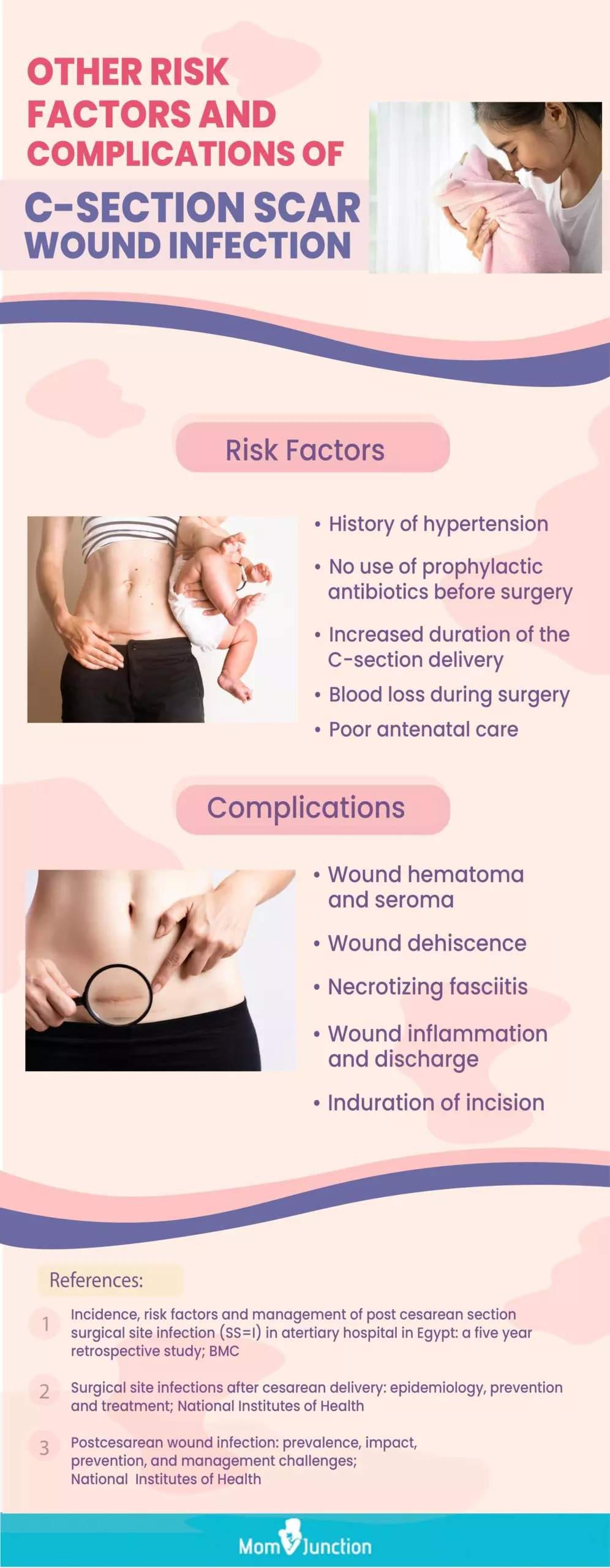
Learn about post-cesarean infection and antibiotic prophylaxis in this informative video. Understand the risks and how to prevent them with the right treatment.
Personal Experience: Source
MomJunction articles include first-hand experiences to provide you with better insights through real-life narratives. Here are the sources of personal accounts referenced in this article.
i. Infected C-section!!! 2 incisions! (the signs, symptoms and story)!;https://www.youtube.com/watch?feature=shared&v=5AnM8h227is ii. Infection after C-Section… Great!;
https://alittlebitcrunchyinsouthtexas.wordpress.com/2012/07/09/infection-after-c-section-great/
References
- K. B. M Saeed, R. A. Greene, P. Corcoran, and S. M. O’Neill; Incidence of surgical site infection following caesarean section: a systematic review and meta-analysis protocol; BMJ Open: National Center for Biotechnology Information (2017)
https://www.ncbi.nlm.nih.gov/pmc/articles/PMC5253548/ - M. M. Osela; Study on Post Caesarean Section Wound Infection at Misurata Central Hospital and Al-Khoms Teaching Hospital, Libya; IOSR Journal of Dental and Medical Sciences (2016)
https://www.semanticscholar.org/paper/Study-on-Post-Caesarean-Section-Wound-Infection-at-Osela/3a7b1f74fb791dccf816b55c6716a8a195ae07ed?p2df - Dawei Zhu et al.; Risk factors related to surgical wound infection after caesarean section: A systematic review and meta‐analysis; International WOund Journal (2025)
https://pmc.ncbi.nlm.nih.gov/articles/PMC10830388/ - Jido TA, Garba ID. Surgical-site infection following cesarean section in Kano, Nigeria. Ann Med Health Sci Res 2012;2:33-6.
https://pdfs.semanticscholar.org/1419/05a967c0c29cb56779adf2e9c32f7651e687.pdf - T. Kawakita and H. J. Landy; Surgical site infections after cesarean delivery: epidemiology, prevention and treatment; Maternal Health, Neonatology and Perinatology (2017)
https://www.ncbi.nlm.nih.gov/pmc/articles/PMC5497372/ - Cesarean Wound Complications; Department of Obstetrics and Gynecology Cesarean Wound Complications: University of Michigan Health System
https://www.med.umich.edu/1libr/Gyn/BirthCenterTriage/CesareanWoundComplications.pdf - When to call your doctor after cesarean; Health Pages (2018)
https://www.healthpages.org/health-a-z/when-call-doctor-after-cesarean/ - S. Zuarez-Easton, N. Zafran, G. Garmi, and R. Salim; Postcesarean wound infection: prevalence, impact, prevention, and management challenges; International Journal of Women’s Health (2017)
https://www.ncbi.nlm.nih.gov/pmc/articles/PMC5322852/ - C-section Scars; Birth Injury Help Center
https://www.birthinjuryhelpcenter.org/birth-injuries/help-center/c-section-scars/ - E. T. Martin et al.; Diabetes and Risk of Surgical Site Infection: A systematic review and meta-analysis; Infection Control & Hospital Epidemiology (2015)
https://www.ncbi.nlm.nih.gov/pmc/articles/PMC4914132/ - Fatimah Alnafisah et al.; Skin Endometriosis at the Caesarean Section Scar: A Case Report and Review of the Literature; National Library of Medicine (2018)
https://www.ncbi.nlm.nih.gov/pmc/articles/PMC5849346/ - Dah-Ching Ding and Senzen Hsu; Scar endometriosis at the site of cesarean section; National Library of Medicine (2006)
https://pubmed.ncbi.nlm.nih.gov/17175473/ - How Many C-Sections Can A Woman Have? Vital Record
https://vitalrecord.tamu.edu/asked-many-c-sections-can-woman/ - Uterine Rupture; Cleveland Clinic
https://intermountainhealthcare.org/blogs/the-dos-and-donts-of-healing-from-a-csection - Sharon Sung and Heba Mahdy; Cesarean Section; StatPearls [Internet]; National Library of Medicine (2025).
https://www.ncbi.nlm.nih.gov/books/NBK546707/ - The Do’s and Don’ts of Healing from a C-Section; Intermountain Healthcare.
https://intermountainhealthcare.org/blogs/the-dos-and-donts-of-healing-from-a-csection - Cesarean Birth; American College of Obstetricians and Gynecologists
https://www.acog.org/womens-health/faqs/cesarean-birth - S. N. Conner; Maternal Obesity and Risk of Post-Cesarean Wound Complications; American Journal of Perinatol (2014)
https://www.ncbi.nlm.nih.gov/pmc/articles/PMC3796045/ - RITA ANDERSEN LETH et al.; Obesity, diabetes, and the risk of infections diagnosed in hospital and post-discharge infections after cesarean section: a prospective cohort study; AOGS (2011)
https://obgyn.onlinelibrary.wiley.com/doi/full/10.1111/j.1600-0412.2011.01090.x - Daniela Frasca and Natasa Strbo; Effects of Obesity on Infections with Emphasis on Skin Infections and Wound Healing; Journal of dermatology and skin science (2025)
https://pmc.ncbi.nlm.nih.gov/articles/PMC10448872/ - Repeat C-sections: Is there a limit?; Mayo Clinic
https://www.mayoclinic.org/tests-procedures/c-section/expert-answers/c-sections/faq-20058380 - Why it’s important to control your blood sugar before surgery; UPMC
https://www.upmc.com/services/south-central-pa/surgery/optimization-clinic/diabetes/blood-sugar - Chorioamnionitis; Cleveland Clinic
https://my.clevelandclinic.org/health/diseases/12309-chorioamnionitis - Esha R Shanbhag and Veena P; Surgical Site Infections Following Cesarean Section: A Longitudinal Study; Journal of South Asian Federation of Obstetrics and Gynaecology (2025)
https://www.jsafog.com/abstractArticleContentBrowse/JSAFOG/25038/JPJ/fullText - Eyob Shitie Lake et al.; Surgical site infection following cesarean section and its predictors in Ethiopia: A systematic review and meta-analysis; PLOS One (2025)
https://pmc.ncbi.nlm.nih.gov/articles/PMC10956825/ - Ashish Pathak et al.; Incidence and risk factors for surgical site infections in obstetric and gynecological surgeries from a teaching hospital in rural India; BMC Antimicrobial Resistance & Infection Control (2017)
https://aricjournal.biomedcentral.com/articles/10.1186/s13756-017-0223-y - Margaret A. Olsen et al.; Risk factors for surgical site infection after low transverse cesarean section; Infection Control and Hospital Epidemiology: The Official Journal of the society of Hospital Epidemiologists of America (2008)
https://core.ac.uk/reader/70383841? - Emily S Reiff et al.; Antibiotic Prophylaxis for Cesarean Delivery: A Survey of Anesthesiologists; Anesthesiology Research and Practice (2025)
https://pmc.ncbi.nlm.nih.gov/articles/PMC7787788/
Community Experiences
Join the conversation and become a part of our nurturing community! Share your stories, experiences, and insights to connect with fellow parents.
Read full bio of Dr. Christian Pope
Read full bio of Ghazia Shah
Read full bio of Rebecca Malachi
Read full bio of Reshmi Das






